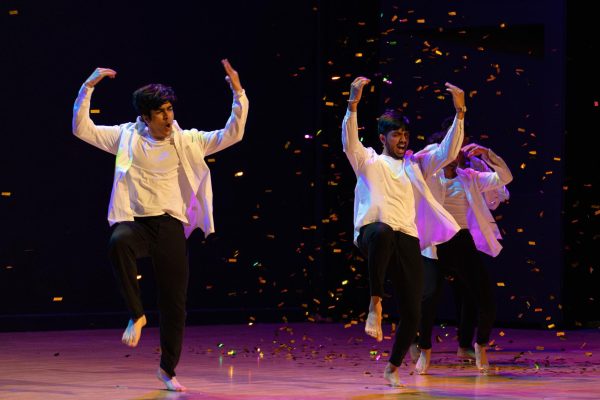ASOSU advances all but two 2019-20 student fee recommendations
January 17, 2019
The Associated Students of Oregon State University held a joint session open to students and the public on Wednesday in the Memorial Union Ballroom. The ASOSU Senators and Representatives cast their votes to either pass or reject official student fee level recommendations for each of the 10 student fee-funded programs on campus.
All recommended student fee levels were advanced, with the exception of Diversity and Cultural Engagement and Athletics’ proposals. These proposals will be advanced to mediation and resolved there, while the other eight proposals will be advanced to ASOSU President Justin Bennett for review.
For each program, representatives gave short presentations. The floor was then open to any Senator or Representative to ask questions or seek clarification. Following the completion of congressional inquiry, students and members of the public were invited to provide testimony about the program. After all testimony, each Senator and Representative cast their vote, determining whether the proposal passed or was rejected.
6-7:30 p.m.
By Chloe Stewart, News Contributor
The first program discussed was the Family Resource Center, which provides access to childcare and student family housing, among other services. The proposed budget for next fall, winter and spring terms would cost each student $11.04 in student fees per term, an 11.26 percent increase from last year’s budget. Of this amount, $0.77 per student would go to bring $50,000 toward childcare subsidies. The summer term proposal would cost students $4.21, a 5.31% increase from last year’s value. This increase would not involve a package deal and reflects the increase believed necessary by the FRC to maintain current service levels. With no student testimony and no public testimony, the proposed budget passed.
Student Leadership and Involvement was discussed next. There are 11 different programs within SLI, including the Student Sustainability Initiative, the Center for Civic Engagement, the Craft Center and more. The proposed budget for fall, winter and spring terms would cost students $39.96 per term, a 2.21 percent increase on last year’s budget. This proposal came with conditions, one of which was that this increase would allow for a reduction in Craft Center membership fees. The proposed summer budget was $23.42 per student, a 5.36 percent increase on last year’s budget. This increase, unlike that of the academic year, would not involve a package deal and would maintain current service levels. After no testimony from students or the public, the proposed budget was passed.
The Diversity and Cultural Engagement program, responsible for supporting overall student diversity and inclusion efforts, followed. DCE is also the body running OSU’s seven cultural centers. In addition, DCE is involved with many events and collaborates with many student organizations. The proposed budget for fall, winter and spring terms was $33.46 per student per term, a 3.5 percent increase. The proposed value for summer term was $9.04, a 5.31 percent increase. Neither of these values came with a package deal and would maintain current service levels.
After legislative inquiry ended, a number of students rose to provide testimony. Each one described the importance and benefits of cultural centers, stressing their belief that these spaces allow a sense of belonging for students who would otherwise feel lost in an institution populated predominantly by white people.
One of the students, Sierra Joyner, a student success peer facilitator at the Native American Longhouse, who is also a member of Orange Media Network, the umbrella organization which The Barometer is under, described how this limited proposed budget could make the cultural center less accessible.
“With a budget decrease, we would have to limit the number of folks who could come in and participate in our events, which really contradicts our goal at DCE,” Joyner said.
Another of the students who testified, Ameyalli Manon-Ferguson, a student leadership liaison at the NAL, discussed how she believes engaging with this space allows Native students to participate in a culture that, while marginalized, is still alive and beautiful–something that white students don’t have to contend with.
“You can’t fully understand the importance of these centers,” Manon-Ferguson said.
When put to a vote, the proposal failed. After the vote, each Senator and Representative in opposition to the proposal was asked to state their reasoning. Each legislator expressed that they were largely in agreement in feeling that DCE was far too important to receive the smallest increase in budget, and that investing in the comfort and experiences of these communities was worth while.
The Performing Arts, including marching band, theater and mock trial was the next program discussed. The proposed budget for fall, winter and spring terms was $6.97 per student per term, with no decision package deal, which would be a 4.5 percent increase from fiscal year 2019.
For summer, there was no proposed budget because there is no summer fee for this unit.
When the floor was opened to student testimony, a single student spoke. Nikolay Galtsev, a member of the OSU mock trial team, expressed that he believes while OSU is often thought of as an engineering and science school, the arts still matter to many students and are deserving of greater credit than they are often given.
Ultimately, the ASOSU legislature voted to pass this budget proposal.
The unit discussed next was Orange Media Network, of which the Daily Barometer is a part. Aside from the newspaper, the network contains six other mediums, including the university radio station and TV network. The proposed cost for fall, winter and spring terms was $19.71 per student per term, a 3.5 percent increase. The proposed summer cost was $11.48 per student, a 5.4 percent increase from last year’s budget. Neither of these values came with a decision package, and would maintain current service levels. After some clarification of equipment use and price by members of the legislature and no testimony from students or the public, the proposal was passed.
Following Orange Media Network was the Human Services Resource Center. The HSRC provides services for students struggling financially, such as a food pantry, a textbook library, temporary housing for students experiencing homelessness and more. The proposed budget for fall, winter and spring terms next year would consist of $12.15 per student per term, a 2 percent increase on last year’s budget. The proposed budget for summer term was $2.86, a 3.85 percent increase. Neither of these figures came with decision packets and would maintain current levels of service.
When a legislator asked for numbers describing this unit’s impact, HSRC Assistant Director Nicole Hindes stated that last academic year, HSRC services had 10,000 student “touch points,” meaning that students reached out for help and utilized their services over 10,000 times. Additionally, 1,700 different students were served last year and each program within the unit is trending an increase in usage.
No student or public testimony occurred, although Millicent Taylor, member of the SFC, briefly rose to comment that she believed that every penny given to the HSRC is spent responsibly. Following this brief statement, the ASOSU legislature voted to pass the proposed budget.
7:30-9:30 p.m.
By Alexis Campbell, News Contributor
After a five minute recess, the session reconvened and began discussing the budget for the Memorial Union. The recommended fee level for the MU was $58.14 for fall, winter and spring, a 6.15 percent increase from FY19, and $47.96 for the summer, a 5.36 percent increase. The budget was passed nearly unanimously, with no testimony or comment.
Next up on the list was Recreational Sports, with a proposed student fee of $89.94 for fall, winter, and spring, a 7.52 percent percent increase from FY19, and $67.16 in the summer, a 5.35 percent increase. One congress member stated that they believe it would reflect poorly on ASOSU to not increase the budget, with Dixon needing so many improvements. Once again, the members voted to pass the budget.
After the first two relatively uncontested budgets, the recommended fees for Intercollegiate Athletics were more contentious at a proposed $41 per student in fall, winter and spring terms, a 5.51 percent increase from last year.
A hotly debated topic was whether student tickets should remain free or cost money.
When it came time for student comments, a group of athletes stepped up to discuss the importance of athletics to OSU, including women’s basketball team member Mikayla Pivec.
“What we have here is special, students love coming to the game and we appreciate it so much,” Pivec said. “We have a home crowd advantage. Without the fees, that number would drop significantly.”
Multiple congress members agreed that athletics are important, but felt that the fees would be more beneficial elsewhere, particularly if they could go to a program helping students in need.
Some, such as Representative Winston Kennedy, felt that this was the wrong approach.
“I think the fee is fine. If you’re basing it off another unit, don’t do that,” Kennedy said to the committee.
In the end, the proposed fee for intercollegiate athletics was voted against, and will go to mediation.
Following that vote was the proposed budget for contingency fees and bad debt, which represent unforeseen expenses and money put towards student fees that go unpaid, respectively.
For fall, winter, and spring term the proposed fee was $0.50, remaining unchanged from FY19. For summer term, the proposed fee was also $0.50, representing a 33% decrease. These fees were passed by the committee.
Last on the agenda was the budget for ASOSU, including the student government, Saferide, the Office of Advocacy, Student Legal Services and the Night Owl bus service.
The proposed student fee level for ASOSU for fall, winter and spring was $23.14, a 3 percent increase, while summer’s proposed fee level was $9.28, a 4.86 percent increase.
The budget for ASOSU was the most controversial issue of the night, as committee members, students and members of the public debated on an intended decrease of funding to the Oregon Student Association.
Simon Brundage, former ASOSU president, commented on the budget.
“When I look at the ASOSU budget as presented, I see the prioritization of students at OSU,” Brundage said. “The aims of OSA are benevolent, but the outcomes fall short.”
Multiple students testified about the importance of OSA in giving opportunities to people of color, undocumented and low-income students.
Student Nikolay Galtsev spoke about how multiple positions within ASOSU would need to be cut if the budget weren’t passed, particularly the environmental coordinator, which would damage environmental goals.
The number of students and members of the public wishing to comment was so high that the congress passed two motions, each extending the session by 10 minutes so that more comments could be heard.
The proposal for ASOSU’s recommended student fee levels was passed, and will advance to President Bennett.
The session ran out of time at 9:30 p.m, half an hour after it was initially scheduled to end.
This story has been updated to correctly reflect Millicent Taylor’s gender, and the outcome of the ASOSU proposal vote.
























































































































